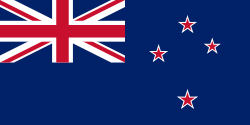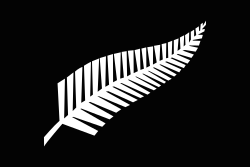New Zealand flag debate
For several years a number of people have been proposing designs for an alternative flag of New Zealand. In November 1979 the Minister of Internal Affairs, Allan Highet, suggested that the design of the flag should be changed, and sought an artist to design a new flag with a silver fern on the fly. The proposal attracted little support however.[1] In subsequent years, alternative designs have been proposed with varying degrees of support.
History
Over a decade after Highet's suggestion for a new flag, in 1998 Prime Minister Jenny Shipley backed Cultural Affairs Minister Marie Hasler's call for the flag to be changed. Shipley, along with the New Zealand Tourism Board, backed the quasi-national silver fern flag, using a white silver fern on a black background as a possible alternative flag, along the lines of the Canadian maple leaf flag.
In 2003, the NZ Flag.com Trust was founded with the aim of bringing about a non-binding referendum on the subject. Under New Zealand law, a referendum may be held on any issue if 10% of electors sign a petition which is presented to Parliament. The Trust launched their petition for such a referendum in 2005.
In response to the petition, the New Zealand Flag Institute was founded to oppose the referendum campaign and promote the current flag, as well as to offer a more scholarly view of the flag. The Royal New Zealand Returned Services' Association (RSA), the New Zealand organisation for war veterans, did not openly back the current flag at its annual conference, calling instead for "...politics to be kept out of the debate".

The petition failed to attract enough signatures (around 100,000 people signed the petition) in time for the 2005 general election in September and was withdrawn in July. The NZ Flag.com Trust cited public apathy to change as the main reason for withdrawing the petition. The New Zealand Flag Institute ascribed the failure of the campaign to public support for the current flag.
There is no consensus among proponents of changing the flag as to which design should replace the flag, though this is not to say that there have been no well-known proposals for an alternative.
The flag debate has been separate from the New Zealand republican debate – the Republican Movement of Aotearoa New Zealand states that "creating a republic does not require any change to the Treaty of Waitangi, flag or Commonwealth membership",[2] while NZFlag has stated that changing the flag "is not anti-royalist in any way".[3]
However opinions as to the ideal alternative are varied, and proponents of changing the flag suggest they would rather leave the final decision on the future flag up to the New Zealand public.
Proposed referendum
On 5 August 2010 Labour list MP Charles Chauvel introduced a members Bill for a consultative commission followed by a referendum on the New Zealand flag.[4]
Arguments for change
Proponents for change argue that the current flag:
- Is very similar to and is sometimes confused with the Australian flag;
- As a defaced Blue Ensign, it alludes to New Zealand being a colony or sub-part of the United Kingdom;
- Ignores New Zealand's Māori heritage and other ethnic groups;
- Does not evoke emotional feelings and is rarely flown by New Zealanders;
- Has little connection with the land;
- Has many designs and colour schemes;
- New Zealand organisation for war veterans do not openly back the current flag;
- Has in recent years been appropriated by nationalist groups such as the New Zealand National Front.[5]
Arguments against change
Opponents to change argue that the current flag:
- Was chosen by New Zealanders;
- Does evoke emotional response;
- Represents the history of the country as a part of the British Empire and location in the southern hemisphere;
- Is a colourful design;
- No one flag challenging the current one;
- Is the flag New Zealanders have fought and died for, and changing it would be greatly offensive to New Zealand's war veterans;
- Has represented the country for over a century.
Some also claim that it is not as similar to the Australian flag as is often suggested, and that many countries have flags that are very similar — or even identical — to the flags of other countries. They also criticise the proposed alternatives, saying they focus on Māori and Pacific designs when most of New Zealand's heritage is Anglo-Saxon and Celtic, or the silver fern which they say is the logo of some of New Zealand's sporting teams rather than the country itself. In response, supporters of the silver fern point out that the leaf itself has been used as a symbol of New Zealand since at least the Boer War (when it featured on military insignia[6]) and is already a national emblem, being used for various official symbols, including the coat of arms of New Zealand and the one dollar coin.
Proposed alternative designs
This section possibly contains original research. (February 2010) |

A flag with a long history as an alternative New Zealand flag is Friedensreich Hundertwasser's Koru Flag, designed in 1983. This flag represents an uncurling fern frond in a stylised form of a traditional Māori carving pattern, the koru. This flag, which is occasionally seen around the country, has a degree of support, especially among alternative lifestylers and similar more liberal groups.

A popular alternative to the current defaced Blue Ensign was designed by Kyle Lockwood (left). It won a Wellington newspaper flag competition in July 2004 and appeared on TV One in 2005 after winning a poll which included the present national flag. The fern represents the people of New Zealand and the stars represent the location of New Zealand. The blue colour represents the ocean, the red represents the Māori and also sacrifices during wartime, and white is a reference to the "Land of the Long White Cloud" (translated from the Māori "Aotearoa").

An earlier (2001) design which also gained a great deal of media publicity was that by James Dignan. This design was produced in newspapers around the country in 2002, at the time of the centenary of the current flag, and may have (at least unconsciously) been a trigger for Lockwood's design. [citation needed] This combines the red, white, and blue and Southern Cross of the current national flag (albeit a lighter blue) with the red, white, and black of the flag of tino rangatiratanga, also incorporating the silver fern on black used to represent New Zealand in many overseas contexts. This combination both looked back to traditional links with the United Kingdom and also forward to New Zealand's current place as a Polynesian cultural centre.

In time for the new millennium (2000) a design appeared in the print and television media presented by Aaron Nicholson. This design was displayed in newspapers around the country in 2005, and on an earlier TV debate with Angela d'Audney.

This re-working of the current national flag with the initials NZ to stylise the Union Jack and a long white cloud (2009) has made it to some a flag of compromise. This combination retains traditional links with the United Kingdom and also New Zealand's Polynesian heritage. The NZ "Jack" design is also reminiscent of the 1974 Christchurch Commonwealth Games insignia.
In 2007, prime minister Helen Clark said deleting the Union Jack from the New Zealand flag was a possibility if people wanted to redesign the flag, leaving it as a "rather attractive Southern Cross."[7]
See also
Notes
- ^ "New Zealand - Proposals for a new flag". Flags of the World. 29 September 2006. Retrieved 2007-09-01.
- ^ "Republican Movement of Aotearoa New Zealand". Republic.org.nz. Retrieved 2010-06-27.
- ^ "New Zealand Flag Change Not Anti-Royalist". Nzflag.com. Retrieved 2010-06-27.
- ^ "Bill advocates consultative debate on new flag". Scoop.co.nz. 5 August 2010.
- ^ "Fight dem back!". Fight dem back!. Retrieved 2010-06-27.
- ^ "Digger History: Badges of New Zealand". Diggerhistory.info. 1915-11-09. Retrieved 2010-06-27.
- ^ "Clark stimulates flag debate with call to rub out Union Jack". New Zealand Herald. Retrieved 2009-07-16.
This article needs additional citations for verification. (January 2010) |
External links


